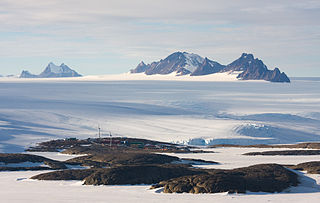Related Research Articles
Skelton Glacier is a large glacier flowing from the polar plateau into the Ross Ice Shelf at Skelton Inlet on the Hillary Coast, south of Victoria Land, Antarctica.
The Deep Freeze Range is a rugged mountain range, over 80 nautical miles long and about 10 nautical miles wide, rising between Priestley and Campbell Glaciers in Victoria Land, Antarctica, and extending from the edge of the polar plateau to Terra Nova Bay. It is southwest of the Southern Cross Mountains, south of the Mesa Range and northeast of the Eisenhower Range of the Prince Albert Mountains.
Lillie Glacier is a large glacier in Antarctica, about 100 nautical miles long and 10 nautical miles wide. It lies between the Bowers Mountains on the west and the Concord Mountains and Anare Mountains on the east, flowing to Ob' Bay on the coast and forming the Lillie Glacier Tongue.

The Sweeney Mountains are a group of mountains of moderate height and about 40 nautical miles extent, located 30 nautical miles north of the Hauberg Mountains in eastern Ellsworth Land, Antarctica.

The Prince Charles Mountains are a major group of mountains in Mac. Robertson Land in Antarctica, including the Athos Range, the Porthos Range, and the Aramis Range. The highest peak is Mount Menzies, with a height of 3,228 m (10,591 ft). Other prominent peaks are Mount Izabelle and Mount Stinear. These mountains, together with other scattered peaks, form an arc about 420 km (260 mi) long, extending from the vicinity of Mount Starlight in the north to Goodspeed Nunataks in the south.

The Framnes Mountains is a group of Antarctic mountain ranges in Mac. Robertson Land, to the south of the Mawson Coast. The range is surrounded by, and largely covered by, an ice sheet.
Hansen Mountains is a large group of nunataks rising to about 300 m (980 ft) above the Antarctic plateau. The mountains are approximately 89 km (55 mi) south of Stefansson Bay and they extend 40 km (25 mi) from northwest to southeast in Kemp Land, East Antarctica. The Hansen Mountains were first mapped by Norwegian cartographers from air photos taken by the 1936–1937 Lars Christensen Expedition. They were named for H.E. Hansen, the Norwegian cartographer who compiled the maps for this and other Norwegian Antarctic expeditions.

The David Range (67°54′S62°30′E is a mountain range that extends for 26 kilometres in the Framnes Mountains of Mac.Robertson Land in Antarctica. The range is surrounded by, and largely covered by, an ice sheet. Only the peaks are visible.
The Lazarev Mountains are a chain of mountains in Antarctica. They extend along the west side of Matusevich Glacier southward of Eld Peak, and are about 25 nautical miles long.

Liv Glacier is a steep valley glacier, 40 nautical miles long, emerging from the Antarctic Plateau just southeast of Barnum Peak and draining north through the Queen Maud Mountains to enter Ross Ice Shelf between Mayer Crags and Duncan Mountains. It was discovered in 1911 by Roald Amundsen, who named it for the daughter of Fridtjof Nansen.
On the continent of Antarctica, the Aramis Range is the third range south in the Prince Charles Mountains, situated 11 miles southeast of the Porthos Range and extending for about 30 miles in a southwest–northeast direction. It was first visited in January 1957 by Australian National Antarctic Research Expeditions (ANARE) southern party led by W.G. Bewsher, who named it for a character in Alexandre Dumas' novel The Three Musketeers, the most popular book read on the southern journey.

The Brown Range or Sørtindane Peaks is a group of seven peaks in the Framnes Mountains about four kilometres (2.5 mi) south of Mount Twintop in Mac. Robertson Land, Antarctica.
Brusen Nunatak is a lone peak 3 nautical miles (6 km) west of Mount Gjeita in the Hansen Mountains. It was mapped and named by Norwegian cartographers working from air photos taken by the Lars Christensen Expedition, 1936–37.
The Gustav Bull Mountains are a small group of bare, rugged mountain peaks and nunataks, lying 4 miles (6 km) inland from the coast and 10 nautical miles (19 km) southwest of Scullin Monolith in Mac. Robertson Land, Antarctica.
The Dwyer Nunataks are a scattered group of low peaks and ridges about 6 nautical miles (11 km) long and 3 nautical miles (6 km) wide, lying 2 nautical miles (4 km) southeast of Mount Gjeita in the Hansen Mountains of Antarctica. They were plotted from Australian National Antarctic Research Expeditions air photos and were named by the Antarctic Names Committee of Australia after V. Dwyer, a radio officer at Mawson Station in 1964, and a member of one of the survey parties which carried out a tellurometer traverse passing through the Hansen Mountains in 1965.
Kjuklingen Nunatak is one of the Dwyer Nunataks, lying 1.5 nautical miles (3 km) east of Mount Gjeita in the Hansen Mountains of Antarctica. It was mapped and named Kjuklingen by Norwegian cartographers working from air photos taken by the Lars Christensen Expedition, 1936–37.
Schmidt Hills is a group of rock hills, 15 nautical miles long, lying north of Childs Glacier and west of Roderick Valley in the Neptune Range of the Pensacola Mountains, Antarctica.
Holyoake Range is a mountain range in the Ross Dependency of Antarctice. It is in the southern section of the Churchill Mountains, part of the Transantarctic Mountains System.
Eidsvold West is a rural locality in the North Burnett Region, Queensland, Australia. In the 2021 census, Eidsvold West had a population of 85 people.